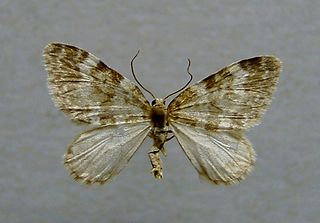
Frass refers loosely to the more or less solid excreta of insects, and to certain other related matter.

A leaf miner is any one of numerous species of insects in which the larval stage lives in, and eats, the leaf tissue of plants. The vast majority of leaf-mining insects are moths (Lepidoptera), sawflies, and flies (Diptera). Some beetles also exhibit this behavior.

Platyptilia gonodactyla, also known as the triangle plume, is a moth of the family Pterophoridae found in temperate Asia and Europe. It was first described by the Austrian entomologists, Michael Denis & Ignaz Schiffermüller in 1775.

Stenoptilia zophodactylus, also known as the dowdy plume, is a species of moth of the family Pterophoridae found worldwide. It was first described by Philogène Auguste Joseph Duponchel in 1840.
Atralata is a genus of moths of the family Crambidae. It contains only one species, Atralata albofascialis, which is found in most of Europe, except Ireland, Great Britain, Norway, Finland, Lithuania and Greece.

Stigmella ruficapitella is a moth of the family Nepticulidae. It is found in northern and central Europe. It is mostly absent in the Mediterranean region, with the exception of Mount Olympus in Greece and Trieste. It has recently been recorded from Russia and Bosnia.

Stigmella suberivora is a moth of the family Nepticulidae. It is widespread in the western Mediterranean region, where it is found in Portugal, Spain, southern France, Italy, Corsica, Sardinia, Sicily, the Adriatic coast in Slovenia, Croatia and Bosnia. It is also found in North Africa, including Algeria and Tunisia. It is an introduced and established species in southern England. Records of leafmines in Mallorca are probably also this species.

Ectoedemia intimella is a moth of the family Nepticulidae which is found in Europe. It flies in June and July and the larva mine the leaves of willows from July to November.

Ectoedemia agrimoniae is a moth of the family Nepticulidae. It is found from Fennoscandia to the Pyrenees, Italy and Greece, and from Great Britain to Ukraine.

Acalyptris pistaciae is a moth of the family Nepticulidae. It is found in the eastern Mediterranean region, where it is widespread in Greece, Cyprus and Turkey. It is probably also present in Syria and Lebanon. Mines collected in Israel in 1931 and identified as Simplimorpha promissa may also belong to be this species.
Trifurcula eurema is a moth of the family Nepticulidae. It is widespread throughout Europe, northwards to southern Norway and Sweden, Poland and the Baltic Region. It is also found in the Mediterranean region, including the larger Mediterranean islands, east to Bulgaria, Asiatic Turkey and Ukraine.

Cosmopterix orichalcea is a moth of the family Cosmopterigidae. It is known from most of Europe east to Japan.

Agonopterix carduella is a moth of the family Depressariidae. It is found from Great Britain, Germany and Estonia to the Iberian Peninsula, Sardinia, Italy and Montenegro.

Antispila hydrangaeella is a species of moth of the family Heliozelidae. It is widespread in the eastern United States, including Georgia, Illinois, Kentucky and North Carolina. However, research suggests that two species might be involved under this name.

Epascestria pustulalis is a species of moth in the family Crambidae. It is found in large parts of Europe, except Ireland, Great Britain, Norway, Finland, Denmark, the Benelux, France, Switzerland, Portugal, Slovenia and Croatia. It is also present in the Near East, including Lebanon and Turkey.

Adscita geryon, the cistus forester, is a moth of the family Zygaenidae. It is found in southern and central Europe, east to Turkey. It is also present in Great Britain.
Acrolepiopsis vesperella is a moth of the family Acrolepiidae. It is found in Germany, France, Spain, Portugal, Italy, Croatia, Serbia and Montenegro, Greece and on the Canary Islands.

Perizoma incultaria is a species of moth of the family Geometridae. It is found from the Alps to the Carpathian Mountains and the mountains of the Balkan Peninsula.
Bucculatrix argentisignella is a moth species in the family Bucculatricidae. It was first described by Gottlieb August Wilhelm Herrich-Schäffer in 1855 and is found in France and in disjunct populations in Central, Eastern and Northern Europe.

Bucculatrix noltei is a moth in the family Bucculatricidae. It is found from Finland to Belgium, Italy and the Crimea and from the Netherlands to Central Russia. It was described by August Arthur Petry in 1912.









